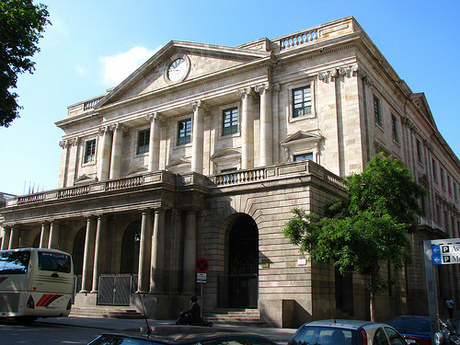La Llotja
On the Pla de Palau, close to the waterfront, stands a building with a neoclassical façade which conceals one of Barcelona’s best-kept secrets: a jewel of Civil Gothic architecture. Throughout its history, the house of La Llotja has been used for a number of purposes, which have all been linked with trade and seafaring life.
The house of La Llotja in Barcelona was built in the 14th century and extended a century later as a goods warehouse and commodity exchange. At the present time, this historic building, the perennial hub of Catalan commerce, and the former seat of institutions such as the Consulate of the Sea, the Royal Assembly of Commerce and the Barcelona Stock Exchange – now on the Passeig de Gràcia – is the corporate headquarters of the Barcelona Chamber of Commerce.
The neoclassical-style building of the La Llotja house we see today was constructed in the 18th century on the site of the medieval commodity exchange. However, much of the original Gothic interior has been preserved. The trading room, and the two-tier Consuls’ Hall in the house, are magnificent examples of its medieval interior. In 1775, La Llotja housed the Reial Acadèmia, an art school which Picasso attended in his youth. Pablo Picasso’s father also taught here. An interesting collection of neoclassical sculptures in the house of La Llotja, with The Dying Lucretia as its most representative work, marks the end of the visit to a historic building from this part of the Mediterranean.
La Llotja once housed an art school which Picasso and Joan Miro attended in their youth. Picasso`s father also taught here. The building was erected in the 14th Century as a commodity exchange and it was one of the first trading houses in Spain. Foreign merchants, local traders and officials carried out their transactions in the large Gothic hall. The facade was remodelled in the 18th Century in the neoclassical style.
Barcelona's Llotja, or trade center was designed to be the city's finest example of civic architecture. Originally little more than a roof, Barcelona's present llotja was constructed in the Catalan Gothic style between 1380 and 1392. At the end of the 18th century the facades were (tragically) covered in the neoclassical uniformity of the time, but the interior, the great Saló Gòtic (Gothic Hall), remained unaltered, and was a grand venue for balls and celebrations throughout the 19th century. The Gothic Hall was used as the Barcelona stock exchange until 1975, and until late 2001 as the grain exchange. The hall has now been brilliantly restored, and though public visits have not been formally established, any chance to see the inside of this historic hall will reveal Gothic arches and columns and a marble floor made of light Carrara and dark Genovese marble. To slip into the hall, after touring the Fine Arts Museum head to the Saló Gòtic by walking down the stairs to the second floor, and then descend the marble staircase and turn right.
The Escola de Belles Arts (Fine Arts School) occupied the southwestern corner of the Llotja from 1849 until 1960. Many illustrious Barcelona artists studied here, including Gaudí, Miró, and Picasso. The Reial Acadèmia Catalana de Belles Arts de Sant Jordi (Royal Catalan Academy of Fine Arts of St. George) still has its seat in the Llotja, and its museum is one of Barcelona's semi-secret collections of art.
Two previous buildings — which had been distinguished by the names antiga (old) and antiquíssima (very old) — having proved insufficient, Peter the Ceremonious authorised the construction of the current building in 1380. The great Gothic hall, the work of Pere Arvei, was finished in 1392; it has three aisles separated by two rows of three large, semicircular arches, held up by four polylobular columns. In 1708 the first opera performances in Barcelona were given there. Very badly damaged during the siege of Barcelona in 1714, later on it became a barracks until, returned to the city (1767), it was rebuilt in a neoclassical style by Joan Soler i Faneca in the years after 1772, preserving the great Gothic hall but not the Sala dels Cònsols (Consuls Hall), also Gothic, masked by Soler and rediscovered in 1971. A large number of fancy dress balls were held there in 1772-1808. Headquarters of the Junta de Comerç (Trade Council) — and later on also of the Cambra de Comerç, Indústria i Navegació (Chamber of Commerce, Industry and Navigation) — it provided a home for the Escola de Belles Arts de Barcelona (Barcelona School of Fine Arts), which is why the school is popularly known as La Llotja, and still today is the home of the Acadèmia de Belles Arts de Sant Jordi (St. George's Academy of Fine Arts) and its art collections. From the 19th century until 1994, the city's stock exchange operated in the Gothic hall. You can get there via direct flight to Barcelona or to Girona, Reus or Lleida–Alguaire.
La Llotja is the hidden gem of Barcelona. Don't forget to ask your travel guide or some local people for it, beause it offers great option for sightseeing and studying something about the spirit of Barcelona.




